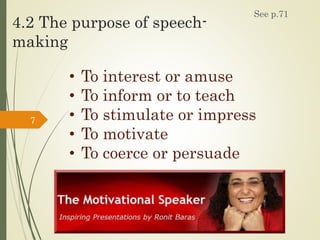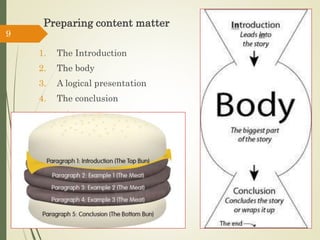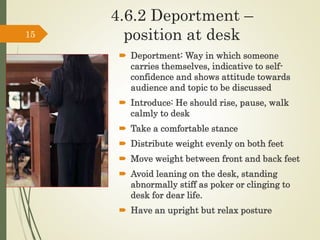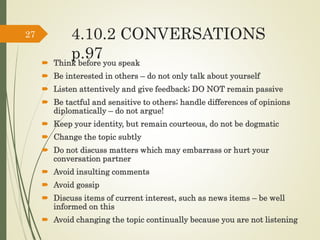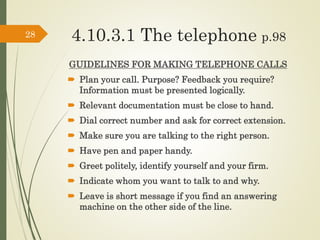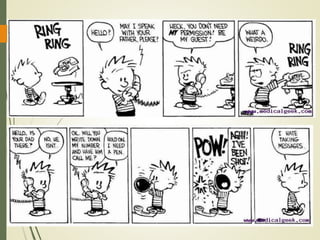N5 Communication TVET Colleges Module 4 Presentation Communication
- 1. Presentation Communication p.70 (N5 students up to 4.10) 1 Did you know the greatest fears include …? • Fear of developing cancer • Fear of getting a heart disease • Fear of having to make public speeches
- 2. Why do you have master the art of presentation? Sooner or later you would have to: Speak in public Addressing large groups Welcome a new employee Propose a toast Thank colleagues Present minutes 2
- 3. A Good presentation depends on: A person’s self-esteem The image and reputation of the organisation of whom the speaker is a representative. Remember: the “self- fulfilling prophesy”? What you think will happen, will happen. One gains faith EVERY time you finish a speech successfully. Practise, practise, practise 3
- 4. 4.1 The role of presentation communication in the communication process See p.71 4
- 5. PRESENTATION COMM Define it in terms of formal communication process Sender (Speaker) Message (specific purpose) Receivers (target audience) Feedback can be Individually (questions) Collectively (applause) Direct (answering question) Indirect (bored listener talking to his friend) Verbal, conscious and positive Asking information Non-verbal, unconscious, neg Bored yawn 5
- 6. Sender: communication barriers SENDER Verbal comm Development of target audience Non-verbal comm Personal appearance Posture (stance) Facial expressions Gestures Quality of his voice COMM BARRIERS Can be any of they above Presentation comm example of direct comm with smaller or larger groups. Speeches are the example of communication with smaller groups or more larger groups That is Presentation Communication 6
- 7. 4.2 The purpose of speech- making See p.71 7 • To interest or amuse • To inform or to teach • To stimulate or impress • To motivate • To coerce or persuade
- 8. 4.3 Factors to consider when preparing a speech (p73) The aim of the speech Response from audience? The audience Size, age, gender, culture The occasion Dictate formality The physical surroundings Geographical situation Quiet/Busy? Size of Hall 8
- 9. Preparing content matter 1. The Introduction 2. The body 3. A logical presentation 4. The conclusion 9
- 10. Content matter of a speech 1. Introduction Advertisement for rest of speech Grab audience’s attention, gain goodwill Indicate purpose & scope Ask questions, humour, interesting quotation, descriptive anecdote Joke should be relevant! 2. The body Researched thoroughly Direct information Oral info Written info Presented logically Chronological Ascending order of importance Ascending order of complexity Congeneric order 10
- 11. Content matter of a speech 3. Conclusion Summary of main points Return to purpose indicated in introduction Appropriate anecdote or quotation Indication how facts can affect listeners Suggestion regarding possible plan of action Listen to Steve Jobs, the founder of Apple Inc. and analyse his speech. 11
- 12. 4.3 Coping with nervous tension See p.74 - 77 12 1. General guidelines • Be yourself • Prepare adequately • Rehearse the speech • Dress appropriately Appearance must match the occasion Comfortable Avoid excessive jewellery or brand new clothes Dress one level smarter 2. Breathing exercises (p76) 3. Relaxation exercises (76) Some causes of nervous tension include: • Lack of self-confidence • Speaker’s fear: lacking verbal skill or knowledge to maintain the audience’s attention • Speaker fearing he might not remember everything he wants to say • Fear of recurrence of some past failure
- 13. 4.6 Non-verbal aspects which determine the success of a speech See p.77 - 81 13 1.APPEARANCE 2.DEPORTMENT AND POSITION AT DESK 3.EYE CONTACT 4.FACIAL EXPRESSION 5.GESTURES 6.RAPPORT WITH THE AUDIENCE 7.VOICE AND VOICE CONTROL OR PROJECTION
- 14. 4.6.1 APPEARANCE (p.77) APPROPRIATE DRESS OUTFIT MUST MATCH OCCASION, AUDIENCE, TOPIC FORMAL: MORE CONSERVATIVE INFORMAL: ALWAYS BE NEAT NEAT APPEARANCE: SELF-RESPECT AND RESPECT FOR AUDIENCE DRESS ONE LEVEL SMARTER THAN AUDIENCE 14
- 15. 4.6.2 Deportment – position at desk Deportment: Way in which someone carries themselves, indicative to self- confidence and shows attitude towards audience and topic to be discussed Introduce: He should rise, pause, walk calmly to desk Take a comfortable stance Distribute weight evenly on both feet Move weight between front and back feet Avoid leaning on the desk, standing abnormally stiff as poker or clinging to desk for dear life. Have an upright but relax posture 15
- 16. 4.6 Non-verbal aspects 4.6.3 EYE CONTACT Pause, run eyes over audience and establish eye contact Maintain throughout speech Avoid looking over heads of audience Avoid staring Get some feedback 4.6.4 FACIAL EXPRESSION Facial expression reflect attitude to message conveyed Smile, grin, raised eyebrows, etc. (use it!) Your expressions are sometimes imitated by audience Words AND expressions = people remembering speech better … 16
- 17. 17
- 18. 4.6 Non-verbal aspects 4.6.5 Gestures Movements of part of the body, especially the head, arms and hands Used incorrectly they are irritating mannerisms Used correctly they emphasise what you say. “Go away!” 4.6.6 Rapport with audience Continuous eye-contact Speak to audience as if speaking during a conversation between two people Choose one or two individuals in audience to focus your attention on. 18
- 19. 4.6.7 Voice & voice control or projection (p.79) QUALITIES OF A GOOD VOICE Pitch (shrillness) Tempo (rate or speed) Pauses (effective punctuation mark) Emphasis Intonation Accent determine this Volume (audible) Use for emphasis Adjust for size of hall Tone (or quality) Intensity of emotion reflected in your voice 19 • Voice is part of your personality • It will reflect emotion, enthusiasm, attitude • Impact determined by words
- 20. 4.7 Applicable language usage See page 81 - 82 20 • Choice of words • Use relevant terminology • Use of ambiguity, repetition, tautology etc. • Clear and coherent ideas • Enthusiasm and liveliness • Audience-oriented language
- 21. 4.8 Visual and other aids See page 82 - 88 21 4.8.1 Designing the audio-visual programme 1. Size 2. Simplicity 3. Unity 4. Emphasis 5. Balance 6. Visual elements • Line • Shape • Space • Colour • Texture
- 22. 4.8 Visual and other aids See page 85 22 4.8.2 Most commonly used media 1. Black (or chalk) and white boards 2. Flip charts 3. Slides 4. The overhead projector 5. Using the microphone
- 23. 4.9 Occasional speeches (p.89) 1. Introducing a colleague or a guest speaker 2. A welcoming speech 3. A farewell speech 4. A presentation speech 5. The speech of acceptance 6. The speech of thanks 7. Making an announcement 8. Proposing a toast 9. The after-dinner speech 23
- 24. How to introduce a guest speaker p.90 T-I-S FORMULA T: Title/Topic of the speaker/ What he will be talking about I: Importance of the speech that is going to be rendered S: Speaker applications for presentations Rise, look at speaker, turn to chairperson and address him Turn to audience and address them Inform the audience of speaker’s qualifications/experience (you might read synopsis out of his CV) Say something about the audience (helps with bridge-building) State topic clearly and correctly Last words: “I would like to welcome – Mr Jones” Lead the applause Introduction not longer than 2 minutes Do not repeat the name of speaker over and over, he might not recognise his cue to rise and start his speech. 24
- 25. 4.10 Actions to promote goodwill See page 95 -103 25 1. Meetings 2. Conversation 3. The telephone • Guidelines for making tel. calls • Guidelines for coping with incoming calls 4. Interviews • Before the interview • During the interview • After the interview 5. Dealing with clients and guests
- 26. 4.10.1 MEETINGS P.96 CORRECT PROCEDURE Beginning: “call meeting to order”. Minutes: “stand approved as read”. Direct the chair. “Mr. Chairman, Madam Chair”. Motions: “I propose that” Vote: “those in favour of” Objections: “I rise to a point of order”. RULES OF CONDUCT Cannot prevent someone from hearing/seeing speaker at a meeting Do not chat, move around No passing between speaker and person speaking Notes should not be passed around No knitting/sewing or playing games on phones 26
- 27. 4.10.2 CONVERSATIONS p.97 Think before you speak Be interested in others – do not only talk about yourself Listen attentively and give feedback; DO NOT remain passive Be tactful and sensitive to others; handle differences of opinions diplomatically – do not argue! Keep your identity, but remain courteous, do not be dogmatic Change the topic subtly Do not discuss matters which may embarrass or hurt your conversation partner Avoid insulting comments Avoid gossip Discuss items of current interest, such as news items – be well informed on this Avoid changing the topic continually because you are not listening 27
- 28. 4.10.3.1 The telephone p.98 GUIDELINES FOR MAKING TELEPHONE CALLS Plan your call. Purpose? Feedback you require? Information must be presented logically. Relevant documentation must be close to hand. Dial correct number and ask for correct extension. Make sure you are talking to the right person. Have pen and paper handy. Greet politely, identify yourself and your firm. Indicate whom you want to talk to and why. Leave is short message if you find an answering machine on the other side of the line. 28
- 29. 4.10.3.2 the telephone GUIDELINES FOR COPING WITH INCOMING CALLS Answer telephone immediately. Must not ring more than 4x. Greet politely; identify yourself and your company. Determine whom you are talking to; from which organisation; whom the caller wants to talk to and why. If the line is engaged: Inquire whether the caller would prefer to hold, to call later or to have his call returned. If the caller prefers the last option mentioned above: Take a message and a telephone number. Repeat numbers, figures and amounts. Make sure that his call does get returned. If the caller prefers to hold: Keep him informed in intervals of 15-20 seconds regarding availability of person. Inquire regularly whether he would still prefer to hold. 29
- 30. 30







